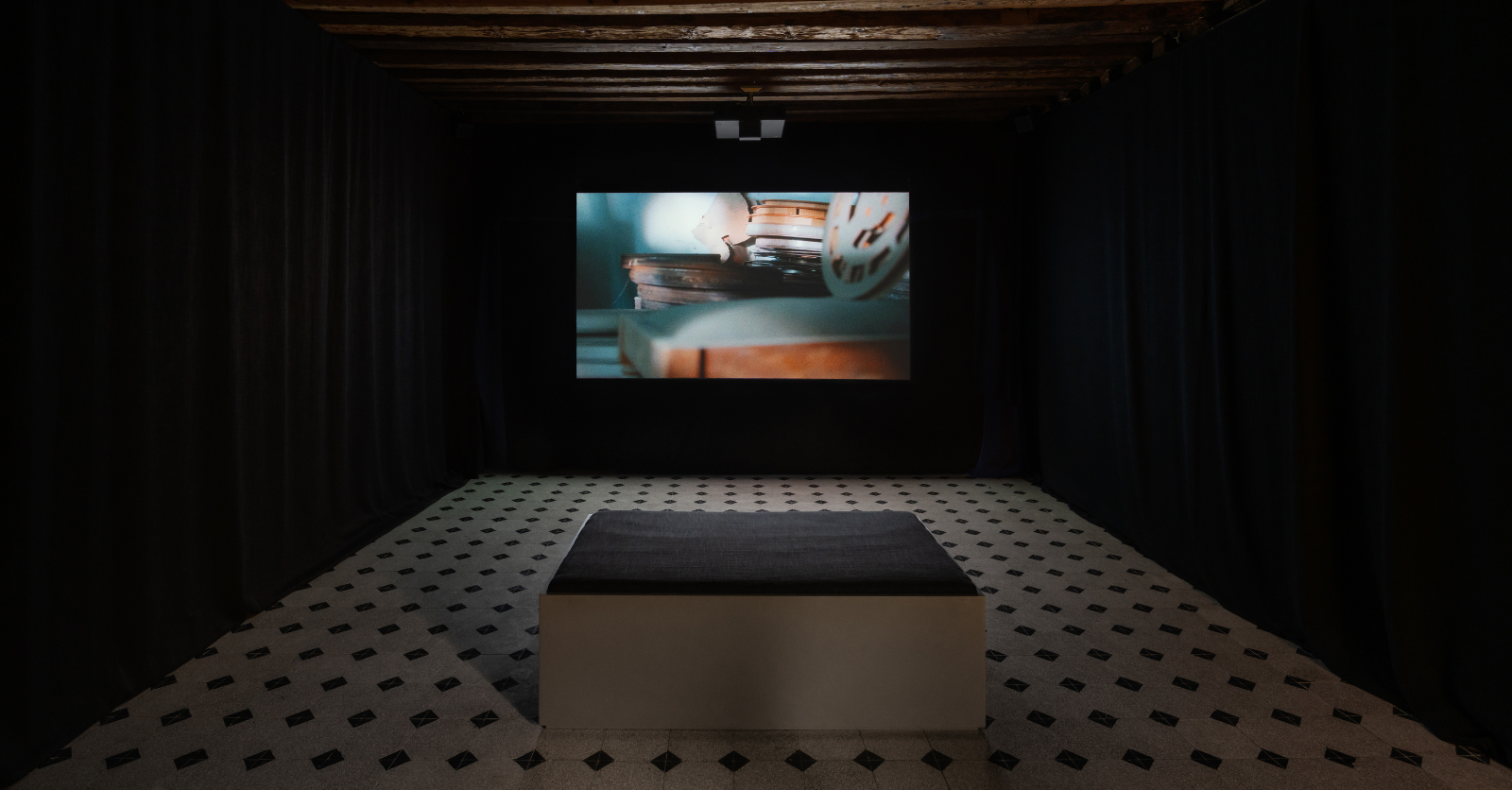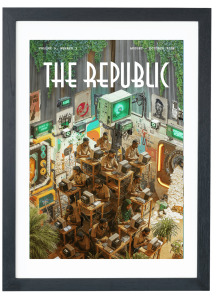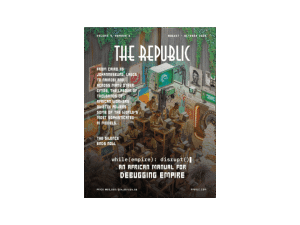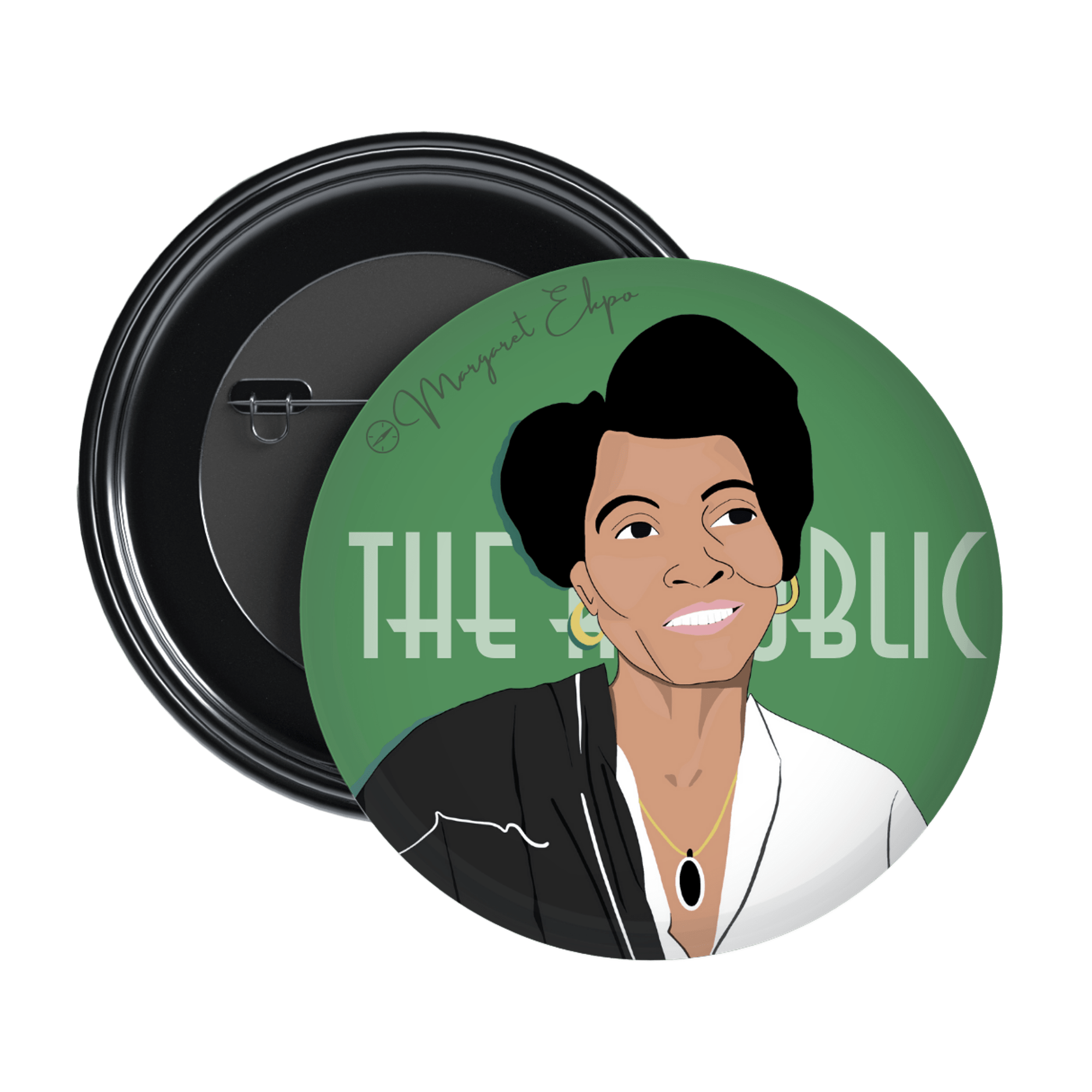
Onyeka Igwe, No archive can restore this chorus of (diasporic) shame, 2024. Installation view, Nigeria Imaginary at the Nigeria Pavilion at the 60th International Art Exhibition — La Biennale di Venezia. MARCO CAPPELLETI STUDIO / MUSEUM OF WEST AFRICAN ART (MOWAA).
THE REPUBLIC INTERVIEWS
‘THE NIGERIA IMAGINARY IS DIALOGICAL’

Onyeka Igwe, No archive can restore this chorus of (diasporic) shame, 2024. Installation view, Nigeria Imaginary at the Nigeria Pavilion at the 60th International Art Exhibition — La Biennale di Venezia. MARCO CAPPELLETI STUDIO / MUSEUM OF WEST AFRICAN ART (MOWAA).
THE REPUBLIC INTERVIEWS
‘THE NIGERIA IMAGINARY IS DIALOGICAL’
The Nigeria Imaginary is dialogical,’ Aindrea Emelife, curator of modern and contemporary art at the Museum of West African Art (MOWAA) and of the Nigeria Pavilion at the 2024 Venice Biennale, told me via email. She was responding to a series of questions I had shared in April 2024, just before the official opening of the 2024 Venice Biennale. For weeks, teams from The Republic and Pavilion organizer, MOWAA, had been reviewing a selection of essays we had commissioned for this special magazine issue on the Nigeria Pavilion; we were also assessing entries for a cover contest we had designed to spearhead the issue. I was curious about the eight artists Emelife had selected for the Pavilion, how diverse and diasporic they were, being based in Nigeria, Canada, the UK and the US. I asked Emelife if she had intended to make a statement about the fluidity of Nigerian identity today. She had not, she said. Instead, her goal was to provoke more general discussion: ‘I ask questions, the artists ask questions, you should leave, hopefully, with even more questions.’ The Pavilion, she explained, ‘is a site of discussion, not a lectern.’
The Pavilion is Nigeria’s second at the Biennale, the first having been in 2017. In her edition, Emelife sought to provoke new questions about Nigerian identity and thinking. ‘Curating with a national objective is a curious task indeed,’ she explained. ‘I received advice early on to try not to get too swept up by politics. That being said, I kept Federal Character in mind, and I wanted to sway towards a greater representation of women artists to correct a historical imbalance.’ Connecting this year’s pavilion to the 2017 pavilion, Emelife noted that, ‘The theme of the first Nigeria Pavilion was “How about now?”—very much interrogating the idea of inclusivity as well as representation. This pavilion takes it on in an even more bombastic way.’
Economically, these are tough times in Nigeria. Questions about the significance of art amidst economic uncertainty, while potentially reductionist (art and artists are also affected by and indeed shape the economy), are inevitable. But what emerged in my conversation with Emelife, was the need to consider this moment as an important opportunity for Nigerians to discuss not only where Nigeria is headed, but also where the country is coming from. In putting together the Pavilion, ‘It was clear from the beginning that there should be a community consultation, to capture the many varying views and perspectives of Nigeria today,’ Emelife said. Yet the success of the Pavilion may not be easy to read just now or deducible through the usual metrics (viewers, reviews etc.). ‘Success, for me, cannot be read immediately,’ Emelife told me. Additionally, with MOWAA intending to stage the exhibition in Edo State later this year, ‘The real success, I hope, will be when this exhibition returns,’ she said. Read our full conversation below.
Our conversation continues below and has been edited for brevity and clarity.

WALE LAWAL
I thought we could start our conversation by discussing the contexts out of which your curatorial vision for the Nigeria Pavilion emerged. Nigeria, to borrow from the late novelist, Chinua Achebe, is often considered just as frustrating as it is exciting. Especially now, many would argue that we are caught between a state of crisis and unfulfilled potential. Your curatorial vision for the Nigeria Pavilion is Nigeria Imaginary. I wondered: how would you describe Nigeria today? In what ways did the so-called ‘Nigerian condition’ inform your curatorial vision for the Nigeria Pavilion?
AINDREA EMELIFE
I think it is important to note that my personal considerations of what ‘Nigeria is today’ is not the sole view that informed the curatorial vision. It was clear from the beginning that there should be a community consultation, to capture the many varying views and perspectives of Nigeria today. A project like this would suffer from individualism. So, the Nigeria Imaginary Incubator Project was born. This project, bridged research and social practice, by interviewing various members of the community—from gatemen to artists, financial executives to musicians—to understand their nostalgias for Nigeria and uncover their own Nigeria Imaginary. The project was staged at Art X Lagos and Edo Fest last year. Amongst many things, it uncovered a relentless state of optimism amongst the frustration. The troubled notion of patriotism is closely related to nationhood. A true patriot demands the highest standards of its country. The Imaginary, in unravelling a sense of criticality, does so in best interest. Cultural identity is born from history, but like all things historical, it can be transformed.
WALE LAWAL
These are very sensitive times in Nigeria as many Nigerians find themselves grappling with harsh economic realities as well as feelings of neglect from our leaders; a moment in which not many people who live in Nigeria feel happy about being Nigerian. Against this, I wondered, why should Nigerians care about the Nigeria Pavilion? How do you imagine those of us living in Nigeria, who are not likely to be in Venice, might connect to the Pavilion?
AINDREA EMELIFE
This was an important consideration from the beginning. An event such as this cannot be an island. I have always been intrigued by the concept of an archipelago, and Édouard Glissant’s idea of many islands. Nigeria Imaginary is evoked in Venice but also in the digital. But importantly, it originates in Nigeria—from the phrases that made up our poster and image campaigns, to the real-life voices that feature in the exhibition, to the quotidian objects loaned from everyday homes to evoke a post-independence spirit that are displayed in the vitrines. There is a vital link created. Frantz Fanon wrote that,
A national culture is not a folklore, nor an abstract populism that believes it can discover a people’s true nature. A national culture is the whole body of efforts made by a people in the sphere of thought to describe, justify, and praise the action through which that people has created itself and keeps itself in existence.
The community is part of the Pavilion.
The Nigeria Imaginary Incubator Project surveyed the minds of today and showcased the direction of collective cultural thinking. It puts you amongst the horns and the yells and the church songs and the singing.

‘I miss being able to have dreams that involved Nigeria.’
‘Nigeria tastes like pepper soup. It’s an acquired taste. Takes some getting used to. It could make your eyes water like Nigeria can. But then once you get the taste of it, and once you get the hang of it, you kind of wonder how you live without it all the time.’
‘Nigeria sounds like the muffled echoes of a thousand people mixed in with a thousand horns at one time.’
The words and sentiments of Nigerians became key grounding points in the development of this exhibition. The community becomes a co-curator.
The exhibition, importantly, will travel back to Nigeria to be the inaugural major contemporary arts exhibition on the MOWAA Campus in Edo State; but before then, collaborations such as this one—with The Republic—as well as an interactive website are some of the few efforts to connect the exhibition with its contextual place of genesis. On our website, you can currently listen to a series of tracks, mixed by Lagos-based sound artist and DJ Kemi Lijadu—or DJ KemKem—who remixed the audio recordings captured during the Nigeria Imaginary Incubators with recorded and archival sounds and music. The website will be updated continually with video interviews with the artists and other content. Our cover art collaboration with The Republic was also spiritually important, allowing for the Nigeria Pavilion platform to activate real economic and career advancing opportunities for young artists in Nigeria.
Truthfully, the most valuable reviews have not been those from international art critics, but the personal messages from artists back home who have said that this project has given them ‘hope’ and they have ‘never felt so proud to be Nigerian.’ We cannot undervalue the power of hope. And of pride.
shop the republic
WALE LAWAL
This will be Nigeria’s second showcase at the Venice Biennale, the first having been in 2017. That was almost ten years ago; in this time, what have you found to be the most noticeable changes within representations of Nigerian and/or African art?
AINDREA EMELIFE
It was important, for me, to resist what I believe to be a still limited view of African Art. Purposefully, the artists represent a broad range of medium—from AR, photography, film, sound, installation, drawing, sculpture, painting. It is important that we are present as innovators. We must resist the monolith.
WALE LAWAL
One question I’m sure you’ve anticipated in curating the 2024 pavilion is how this pavilion connects to and/or departs from the 2017 pavilion. I wondered if you could share some details on this: what conversations from 2017 do you seek to continue through the 2024 pavilion and what new, original conversations do you seek to spark?
AINDREA EMELIFE
The theme of the first Nigeria Pavilion was ‘How about now?’—very much interrogating the idea of inclusivity as well as representation. This pavilion takes it on in an even more bombastic way. It celebrates how expansive Nigerian art is, it dips a toe into our vast history in order to uncover just how limited the story that we have been told is. It boldly asserts the time is definitely now. Like the late Okwui Enwezor said, the future belongs to Africa because it seems to have happened everywhere else. We must revel in the Imaginary and join in a collective dreaming of what is yet to come.
shop the republic
WALE LAWAL
I am also very curious about the mix of artists who will be showcasing at the Pavilion. There are eight of them—Tunji Adeniyi-Jones, Ndidi Dike, Onyeka Igwe, Toyin Ojih Odutola, Abraham Oghobase, Precious Okoyomon, Yinka Shonibare CBE RA and Fatimah Tuggar. Almost immediately, what strikes me about this group is how their mix of identities very closely captures the reality of Nigeria—as hypermobile, as local but equally diasporic, but most importantly as connected. How did you decide on which artists to feature? What statement, as curator, did you seek to make about the meaning of Nigerian art?
AINDREA EMELIFE
Curating with a national objective is a curious task indeed. I received advice early on to try not to get too swept up by politics. That being said, I kept Federal Character in mind, and I wanted to sway towards a greater representation of women artists to correct a historical imbalance. The artists are purposefully cross-disciplinary and intergenerational to ensure a variety of ‘imaginaries’ and to make clear the diversity, similarity and difference, and expansiveness in Nigeria. I had largely never worked with the chosen artists before. I say often that the Nigeria Imaginary was ‘summoned’. As a curator, I have worked instinctively and led by feeling. As my own personal Nigerian-ness continues to unfold, I was drawn to artists that aligned and whose message and stories tell a story of a rich past, a disquiet present and a shape-able future.
I did not intend to make a statement. The Nigeria Imaginary is dialogical. I ask questions, the artists ask questions, you should leave, hopefully, with even more questions. It is a site of discussion, not a lectern.

WALE LAWAL
You’ve also mentioned that these artists will be showcasing works that ‘function like points in a manifesto.’ I’m drawn to the word manifesto and wondered if you could share more on this. As featured artists what is their collective message? Is this message political?
AINDREA EMELIFE
Each artist has their own message. Purposefully so.
Many of these artists take moments from history as starting points, sitting within these imagined pasts to consider new configurations of both the past and the present.
The Nigeria Imaginary proposes a tandem de- and post- coloniality. The history of post-independence African nations has been in danger of fragmented, single-author storytelling. Artists now imagine futures that transcend coloniality, and in reckoning with these alternate futures, posit ways to shape our future history.
Together, they reflect the historical condition of the contemporary present and propose alternative realities for the future. On this occasion, Nigeria is retold through politics, memory, and desire. A Nigeria that could have been and can still be. It is an understanding of where we are, and what we have become—and it is a preview of what lies ahead.
shop the republic
WALE LAWAL
Your vision for the pavilion is also rooted in nostalgia and memory, which in Nigeria, often means thinking about the independence era, a period of palpable optimism. Here I wondered two things: why is nostalgia an important device?
AINDREA EMELIFE
In Lacanian theory, the Imaginary is not just fanciful or fictional, it is essential to our ordinary life and functions. Lacan identifies the Imaginary as necessary fiction and key to allowing for someone to engage with their surroundings. The absence of these fictions frames the ‘Real’ as unbearable, unstructured and inharmonious. The Imaginary is made up of illusions that combine to form vision and structure, and to bolster harmony and unity between peoples and places.
It is important to analyse the circumstances that coalesce to create cause for deep imagining. A nation thrust forward by the winds of history—what sum of events, feelings, missteps and overzealousness allows its citizens to maintain a deep sense of optimism in tandem with a heightened criticality? This curious contradiction lends itself to a state of patriotic yearning.
WALE LAWAL
Secondly, if you could bring back to life any artist from that era and include their works in the Pavilion, who would it be and why?
AINDREA EMELIFE
The exhibition features work from the post-independence era, especially artists related to the Art Society and Mbari Club. Uche Okeke’s drawings, Ben Enwonwu’s letters, Ladi Kwali’s pottery are all featured. If I could feature a late artist in the Pavilion, I would have included Colette Omogbai. We don’t know much of her work, but her painting, Agony (1963), is immensely interesting. She is also the author of the 1965 manifesto, ‘Man Loves What Is Sweet and Obvious’, in which she criticized the dominant paradigm of representational painting. I feel her work would contribute further to the already established focus on Nigerian woman artists, but also to the resistance of conformity. It is important that a ‘national style’ is resisted and Omogbai, it seemed, may agree.
shop the republic

WALE LAWAL
The Venice Biennale is a hallmark event in the global art world. In your view, what makes a country’s pavilion successful? More specifically, what would make you register the 2024 Nigeria Pavilion as a success?
AINDREA EMELIFE
Success, for me, cannot be read immediately. I am humbled to have seen the many positive reviews and listened to the positive feedback first hand. But the most important metric is the galvanizing spirit this can create for artists back home. That being said, I am encouraged by the international response—people have said the Pavilion has uncovered prejudices they did not know they had and expanded their mind. If this allows for people to consider our nation differently, and to unlock deep thinking, new ways of seeing and new collaborative opportunity, that would be a success. There is much work to do. This is just the start. We need everyone on board.
The real success, I hope, will be when this exhibition returns. There, it will reach its intended audience. I look forward to the value the show can bring when it comes home⎈























